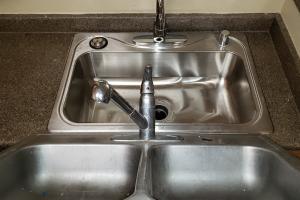Step-by-Step Guide to Replacing Your Kitchen Sink: A Comprehensive Approach

-
Quick Links:
- Introduction
- Tools and Materials Needed
- Preparation Steps
- Removing the Old Sink
- Installing the New Sink
- Connecting the Plumbing
- Final Steps and Cleanup
- Case Studies and Examples
- Expert Insights
- FAQs
Introduction
Replacing a kitchen sink can seem daunting, but with the right tools and guidance, it’s a manageable DIY project. Whether you’re looking to upgrade your sink's functionality or simply want a fresh look, this guide will provide you with all the necessary steps and tips to successfully replace your kitchen sink.
Tools and Materials Needed
Before you start, gather the following tools and materials:
- Adjustable wrench
- Plumber's putty
- Screwdriver set
- Pliers
- Bucket
- New kitchen sink
- New faucet (if applicable)
- Sealant
- Cleaning supplies
Preparation Steps
Preparing your workspace is crucial for a successful sink replacement. Follow these steps:
- Turn off the Water Supply: Locate the shutoff valves under your sink and turn them clockwise to stop the water flow.
- Clear the Area: Remove all items from under the sink to create a clean working space.
- Gather Your Tools: Ensure all necessary tools are within reach to avoid interruptions during the project.
Removing the Old Sink
Follow these steps to safely remove your old sink:
- Disconnect the Drain: Use a bucket to catch any water and unscrew the drain assembly.
- Disconnect the Water Supply Lines: Using the adjustable wrench, loosen the nuts connecting the water supply lines to the faucet.
- Remove the Sink Clips: If your sink is secured with clips, remove them using a screwdriver.
- Lift Out the Old Sink: Carefully lift the old sink out of the countertop. You may need assistance if the sink is heavy or awkward.
Installing the New Sink
Now it's time to install your new sink. Follow these steps:
- Apply Plumber’s Putty: Roll a rope of plumber's putty and place it around the edge of the sink cutout.
- Set the New Sink: Place your new sink into the cutout, ensuring it fits snugly.
- Secure with Clips: If your sink comes with clips, secure them in place to prevent movement.
Connecting the Plumbing
Reconnect the plumbing to your new sink:
- Connect the Drain: Reinstall the drain assembly and ensure it’s securely tightened.
- Reconnect Water Supply Lines: Use the adjustable wrench to reconnect the water supply lines to the faucet.
Final Steps and Cleanup
After everything is connected, follow these final steps:
- Turn On Water Supply: Slowly turn on the water supply and check for any leaks.
- Seal Edges: Apply sealant around the edges of the sink if necessary.
- Clean Up: Dispose of old materials and clean the area.
Case Studies and Examples
Understanding real-world scenarios can be helpful. Here are a couple of case studies:
Case Study 1: A Small Kitchen Upgrade
For a small urban kitchen, a homeowner replaced an outdated double sink with a modern single basin sink. They reported improved functionality and an aesthetic upgrade.
Case Study 2: An Eco-Friendly Choice
A family opted for a stainless steel sink made from recycled materials. This choice not only enhanced their kitchen's look but also contributed to sustainability.
Expert Insights
We consulted with plumbing expert Jane Doe, who provided valuable tips for a successful sink replacement:
"Always check for leaks after installation. It’s better to address them immediately rather than deal with water damage later."
FAQs
1. How long does it take to replace a kitchen sink?
Typically, it takes about 2-4 hours depending on your experience level and the complexity of the installation.
2. Do I need a plumber to replace my sink?
No, many homeowners successfully replace their sinks themselves. However, if you’re not comfortable with plumbing, consider hiring a professional.
3. What type of sink is best for my kitchen?
It depends on your needs. Stainless steel is popular for its durability, while porcelain offers a classic look.
4. Can I replace my sink without removing the countertop?
In many cases, yes. However, this depends on how the sink is installed. If it's under-mount, you will likely need to remove the countertop.
5. What should I do if I encounter leaks?
Turn off the water supply immediately and check all connections. Tighten any loose fittings and recheck for leaks.
6. How do I choose the right size sink?
Measure your existing sink or the cutout to ensure the new sink fits properly.
7. Is it necessary to use plumber's putty?
While not always necessary, plumber’s putty helps create a watertight seal. It’s recommended for optimal results.
8. Can I install a new faucet at the same time?
Yes, it’s a great time to install a new faucet since you’ll have access to the plumbing connections.
9. What materials are best for sink construction?
Stainless steel, porcelain, and composite materials are popular due to their durability and aesthetic appeal.
10. How do I maintain my new sink?
Regularly clean your sink with mild soap and water, and avoid abrasive cleaners to maintain its finish.
Conclusion
Replacing your kitchen sink can be a rewarding DIY project that enhances your kitchen's functionality and appearance. By following this comprehensive guide, you can confidently tackle this task and enjoy the satisfaction of completing it yourself.